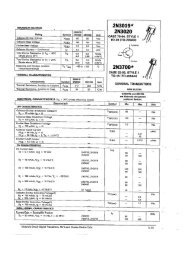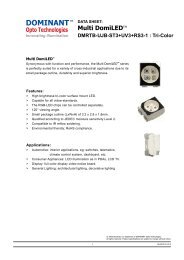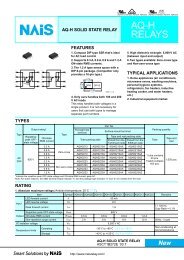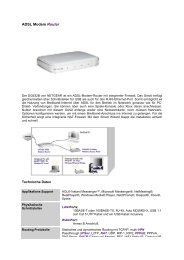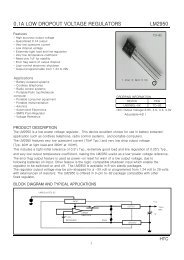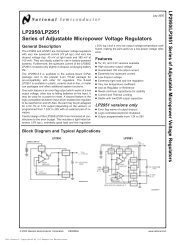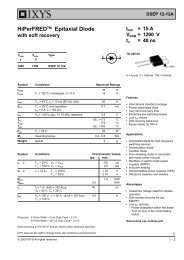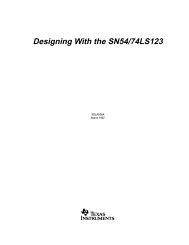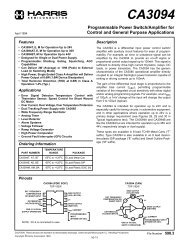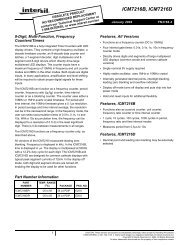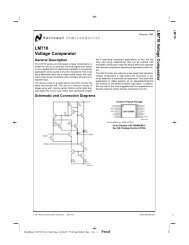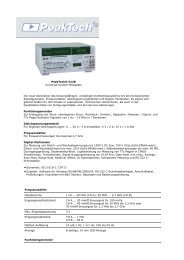LT3080 - Adjustable 1.1A Single Resistor Low Dropout Regulator
LT3080 - Adjustable 1.1A Single Resistor Low Dropout Regulator
LT3080 - Adjustable 1.1A Single Resistor Low Dropout Regulator
Create successful ePaper yourself
Turn your PDF publications into a flip-book with our unique Google optimized e-Paper software.
<strong>LT3080</strong><br />
APPLICATIO S I FOR ATIO<br />
The power in the drive circuit equals:<br />
PDRIVE = (VCONTROL – VOUT)(ICONTROL)<br />
where ICONTROL is equal to IOUT/60. ICONTROL is a function<br />
of output current. A curve of ICONTROL vs IOUT can be found<br />
in the Typical Performance Characteristics curves.<br />
The power in the output transistor equals:<br />
POUTPUT = (VIN – VOUT)(IOUT)<br />
The total power equals:<br />
PTOTAL = PDRIVE + POUTPUT<br />
The current delivered to the SET pin is negligible and can<br />
be ignored.<br />
VCONTROL(MAX CONTINUOUS) = 3.630V (3.3V + 10%)<br />
VIN(MAX CONTINUOUS) = 1.575V (1.5V + 5%)<br />
VOUT = 0.9V, IOUT = 1A, TA = 50°C<br />
Power dissipation under these conditions is equal to:<br />
PDRIVE = (VCONTROL – VOUT)(ICONTROL) I CONTROL = I OUT<br />
60<br />
14<br />
1A<br />
= = 17mA<br />
60<br />
PDRIVE = (3.630V – 0.9V)(17mA) = 46mW<br />
POUTPUT = (VIN – VOUT)(IOUT) POUTPUT = (1.575V – 0.9V)(1A) = 675mW<br />
Total Power Dissipation = 721mW<br />
C1<br />
U W U U<br />
VCONTROL<br />
<strong>LT3080</strong> IN<br />
+<br />
–<br />
SET<br />
RSET OUT<br />
Figure 8. Reducing Power Dissipation Using a Series <strong>Resistor</strong><br />
R S<br />
C2<br />
3080 F08<br />
VIN<br />
V INʹ<br />
VOUT<br />
Junction Temperature will be equal to:<br />
TJ = TA + PTOTAL • θJA (approximated using tables)<br />
TJ = 50°C + 721mW • 64°C/W = 96°C<br />
In this case, the junction temperature is below the maximum<br />
rating, ensuring reliable operation.<br />
Reducing Power Dissipation<br />
In some applications it may be necessary to reduce<br />
the power dissipation in the <strong>LT3080</strong> package without<br />
sacrifi cing output current capability. Two techniques are<br />
available. The fi rst technique, illustrated in Figure 8, employs<br />
a resistor in series with the regulator’s input. The<br />
voltage drop across RS decreases the <strong>LT3080</strong>’s IN-to-OUT<br />
differential voltage and correspondingly decreases the<br />
<strong>LT3080</strong>’s power dissipation.<br />
As an example, assume: VIN = VCONTROL = 5V, VOUT = 3.3V<br />
and IOUT(MAX) = 1A. Use the formulas from the Calculating<br />
Junction Temperature section previously discussed.<br />
Without series resistor RS, power dissipation in the <strong>LT3080</strong><br />
equals:<br />
PTOTAL = ( 5V – 3.3V)•<br />
1A � �<br />
�<br />
�<br />
60�<br />
�<br />
= 1.73W<br />
+ ( 5V – 3.3V)•1A<br />
If the voltage differential (V DIFF) across the NPN pass<br />
transistor is chosen as 0.5V, then RS equals:<br />
R S<br />
= 5V – 3.3V − 0.5V<br />
1A<br />
= 1.2Ω<br />
Power dissipation in the <strong>LT3080</strong> now equals:<br />
P TOTAL<br />
� 1A �<br />
= ( 5V – 3.3V)•<br />
�<br />
�<br />
60�<br />
�<br />
+ ( 0.5V)•1A=<br />
0.53W<br />
The <strong>LT3080</strong>’s power dissipation is now only 30% compared<br />
to no series resistor. RS dissipates 1.2W of power. Choose<br />
appropriate wattage resistors to handle and dissipate the<br />
power properly.<br />
3080f



